The Polar Grit X is very good... if you want a super specialized sport smartwatch. You have to sacrifice some convenience for these features.
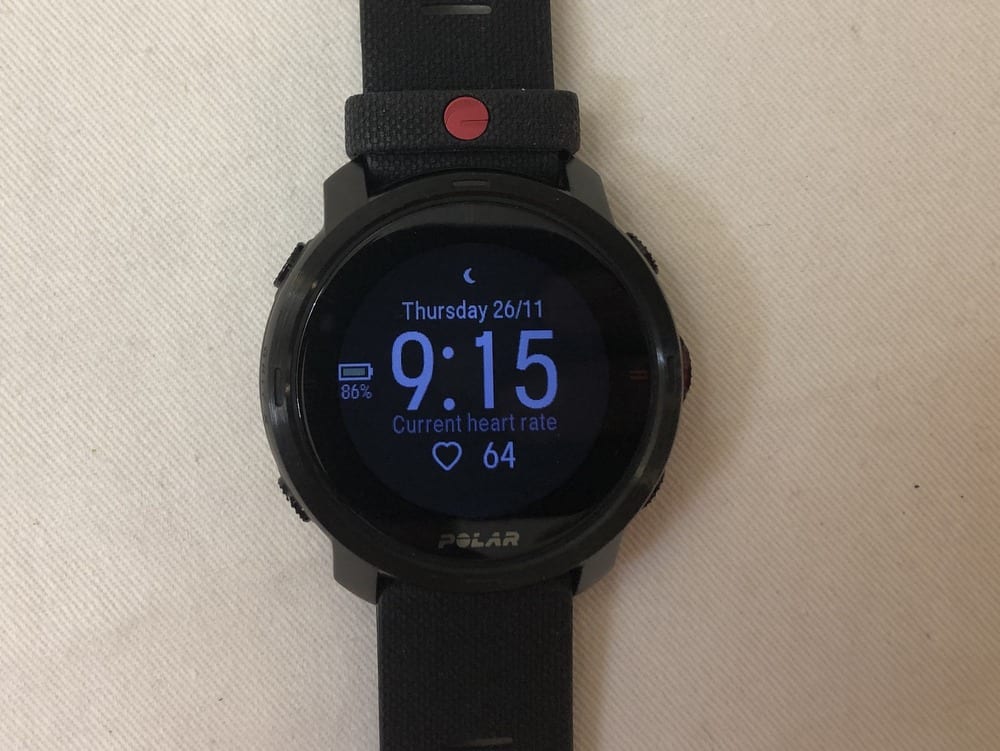
Every time I use a Polar smartwatch, I find that I have to sacrifice a lot of conveniences that I am used to with other smartwatches in order to enjoy the special features that only Polar can provide.
When I first put on the to review it, I was reminded so much of my experience with the . The is a really specialized tool meant to help you improve your fitness and sporting ability. It’s an algorithmic coach that’s on your wrist, and ideally worn 24/7.
This computerized coach doesn’t stray from its main purpose. Even with other sport smartwatches such as the Suunto 7 and 6, I get features such as useful notifications, music and maps that I don’t get on the .
The had to be worn 24/7 because it monitors your overall health and gives you recommendations from how you , your level of activity and its intensity.
It’s a pretty large to be worn overnight. Wearing a overnight was a new concept to me when I first entered this world, but it has now become much more normal. The is somewhat uncomfortable, but not to the level that the 6 is, but definitely much more noticeable than the Fitbit Sense or Versa 3.
Contents
- Sacrifice #1: touchscreen
- Sacrifice #2: convenience with notifications
- Sacrifice #3: music
- Sacrifice #4: ANT+
- Daily use(less)
- So what’s the upside to the Polar Grit X?
- Battery life
- Polar Grit X or Vantage V?
- Unique feature #1: Hill Splitter
- Unique feature #2: FuelWise™ smart fueling assistant
- Unique feature #3: Polar Precision Prime heart rate sensor
- Route guidance
- Sports tracking
- Running power, cadence and planning
- VO2Max measurement
- Swimming metrics
- Watch faces that’s all about keeping active
- Verdict
- FAQs
- Polar Grit X vs Suunto 7
- Polar Grit X vs Polar Vantage V
- Polar Grit X vs Garmin Fenix 6
- Polar Grit X vs Fitbit Sense
- Polar Grit X vs Fitbit Versa 3
- Polar Grit X vs Apple Watch Series 6
- Polar Grit X vs Fossil Gen 5 Carlyle
- Polar Grit X vs Fossil Sport Smartwatch
- Polar Grit X vs Ticwatch Pro
- Polar Grit X vs Ticwatch C2/E2/S2
- Polar Grit X vs Samsung Galaxy Watch3/Active2
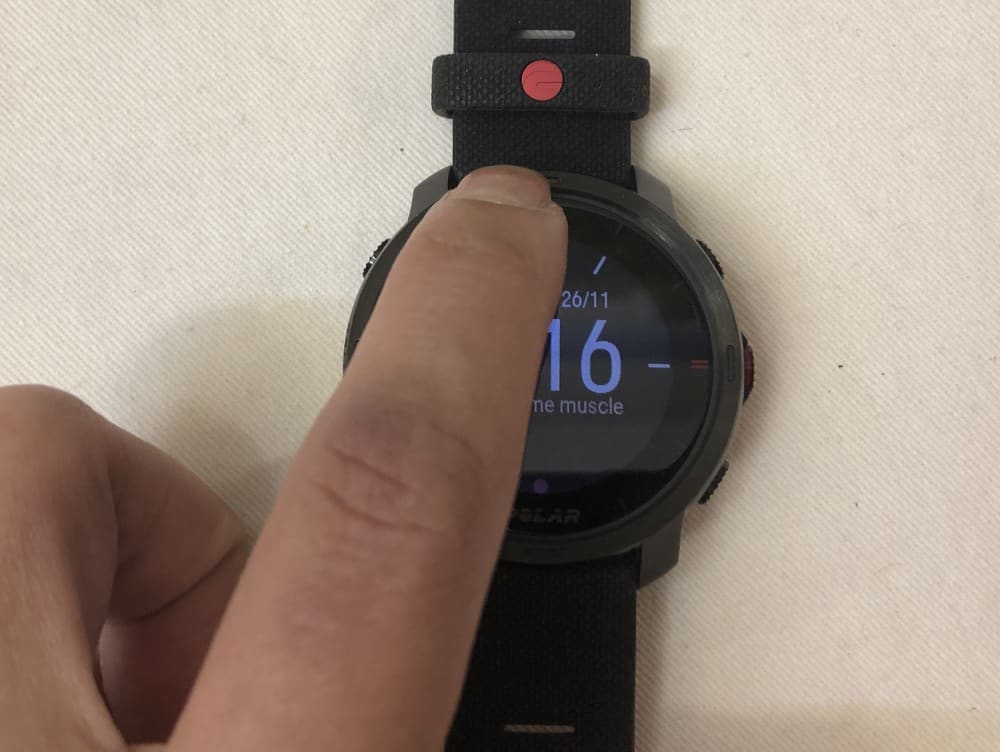
Sacrifice #1: touchscreen
Most smartwatches have a touchscreen and so does the .
The problem is that the touchscreen is one of the worst. It’s not very responsive and can sometimes take a few tries before it properly detects your swipe.
For example, if you wanted to see your notifications, you had to swipe up. That’s a bit difficult sometimes because the smartwatch just won’t detect the swipe. Only upon random chance would you have done it right and the will respond.
Luckily, the has five buttons surrounding the case. I find this very important for sport smartwatches because even with the best touchscreen, you just don’t have time to tap on the touchscreen when you are in the heat of a .
Buttons that have a designated function are much more reliable and because the touchscreen is difficult to use, the buttons can come in really handy.
This is, of course, once you figure out which button does what. This can take a lot of time to familiarize yourself as their functions vary between screens.
I am of two minds as to whether a touchscreen is a “nice to have” or an annoyance. The 6 has no touchscreen, but I got really used to interacting with that with its five buttons. Whereas, a fantastic touchscreen on the Fitbit Sense or Suunto 7 really made some things a lot easier. The Suunto 7 has four buttons and really complements the touchscreen experience.
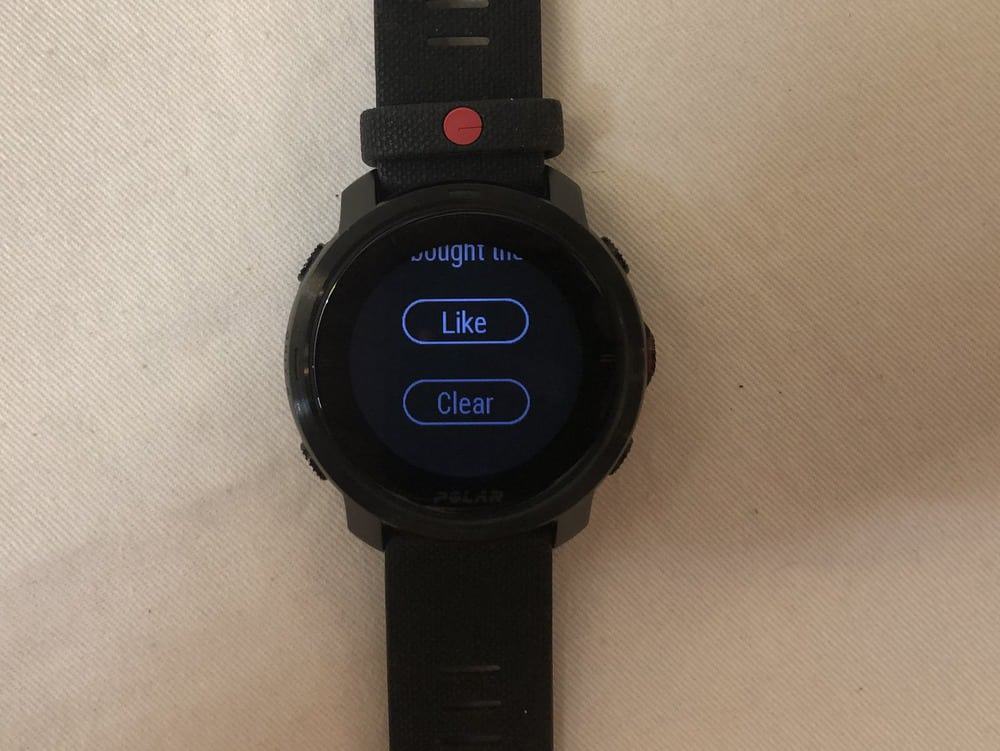
Sacrifice #2: convenience with notifications
The can receive your phone’s notifications, but don’t bother if you want to reply.
Let’s put this into context: most other smartwatches will offer some ability to reply to a message. The Polar tricks you into thinking it can, then disappears.
I figured out why this is happening. When my Samsung Galaxy Note receives a notification, (the smartphone app) will receive it and then forward it to my smartwatch.
It doesn’t matter what kind of notification. If you play music, it will be a notification. If you receive a text, it will appear as a notification. Basically, your will reflect what you see on your lock screen.
On an Android 10 device, if you pull a specific notification down, you will see a range of interaction options. With Spotify, you can skip tracks, “like” the track, etc. With texts, you see a button for reply or “mark as read.”
These get reflected on the . So when I saw the “reply” button to a text, I thought the had a function to reply.
I was wrong. Upon pressing that, the notification disappeared. It didn’t work and I was left flustered until I figured out what was going on behind the scenes.
Sacrifice #3: music
I never thought about how important music was until I used the Suunto 7. I liked how I could go into my music app with the press of one button, then skip tracks with another.
The 6 also has internal storage for music and also access to Spotify and other music services.
The has no such .
Sacrifice #4: ANT+
The can connect to other Bluetooth devices such as a chest-based strap but if you have a device that requires ANT+, you are out of luck. So no ANT+ cycling power meters or straps.
Depending on what kind of accessories you have, this might be make-or-break. In contrast, the Garmin Fenix 6 supports both ANT+ and Bluetooth accessories, so you might do better with that if you already have a bunch of accessories.
Daily use(less)
Daily utility of the is underwhelming if you expect it to be on par with other smartwatches. There are better watches out there that give a better balance between productivity enhancements and sport tracking features.
So what’s the upside to the ?
Luckily, despite all the sacrifices, there are many upsides to the .
It’s an elite sports smartwatch and really focuses on nothing but sports much more than any other in the same class.
One very important thing about the is its very good . I received the on a Friday and only had to charge it on Tuesday when the battery level dropped to 29%.
This is a very important for people looking to do sports that lasts for hours and hours such as ultra running or randonneuring.
Since the uses a LCD screen that uses ambient light to illuminate the screen, it avoids the battery hog of an LED screen that requires constant backlighting. Rather, with the , you only turn on the backlight if the environment is too dark.
The also has battery saving options that allow you to set the GPS data refresh interval. GPS is one of the biggest battery users so reducing this will give you less granular location data but better .
or Vantage V?
I’ll have to note here that the isn’t much different from the , but let’s start with the main features that the has over the Vantage V:
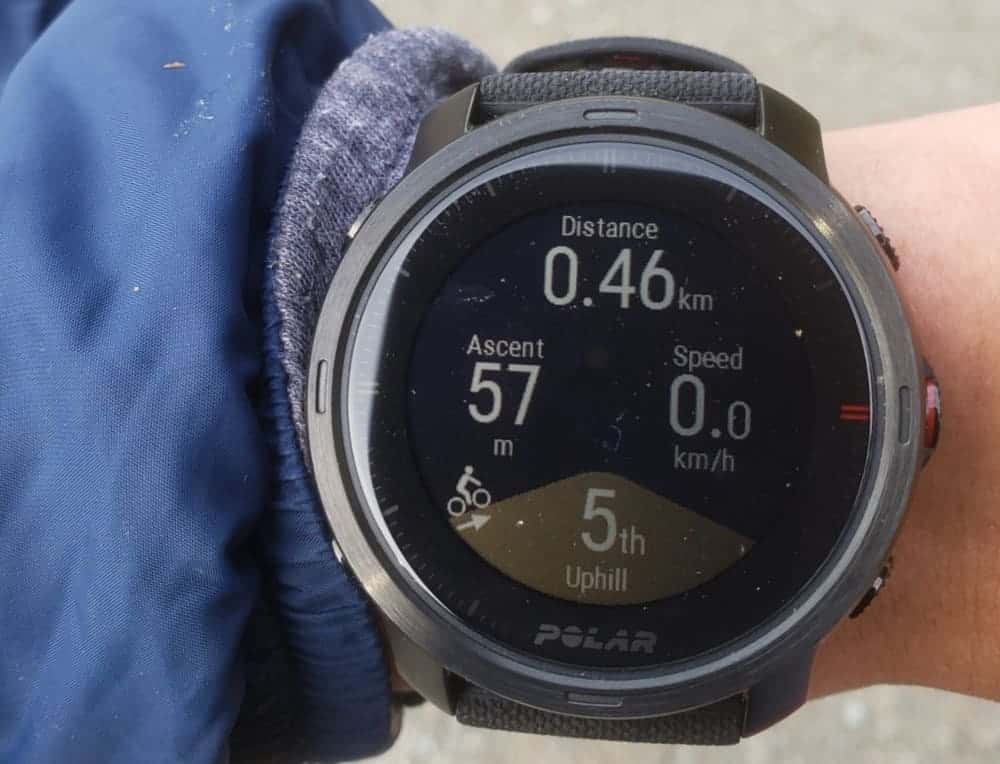
Unique #1: Hill Splitter
The Hill Splitter gives you information about your distance, change in altitude, speed and how many uphills/downhills you have done in this
Polar says the Hill Splitter will automatically judge what’s a hill depending on the terrain you’re in. So, on a relatively flat course, small hills will count.
The Hill Splitter is a good tool to use if you are looking to improve your hill climbing abilities and is active automatically on all running, cycling and downhill type sports.
As a casual, non-racing, mountain biker, I haven’t really had much use for this , other than in a “good to know” way.

Unique #2: FuelWise™ smart fueling assistant
Cyclists call it “bonking” and I remembered when that happened many years ago.
I was able to keep up with my fellow riders until a point where I “bonked.” Suddenly, I trailed behind them further and further.
Luckily, these days, I ride alone. I rejected reality and substituted it with my own preferred reality.
What I needed back then was the , but that incident happened in the days of the Palm personal digital assistant devices, so we weren’t even there yet in terms of technological capability.
The has a that reminds you to refuel with a serving of carbs and to drink water. It will also advise you as to how much carbs you should bring in order to fuel your .
While working out, it will use data from your vital signs and adjust automatic fuelling reminders in line with your carbs expenditure. When you hit a certain amount of time or energy expenditure, it will tell you to eat carbs or drink water.
At the end of your , it will tell you how much energy you’ve used in this . Then, it will also tell you the percentage of those calories that were derived from carbs, protein and fat.
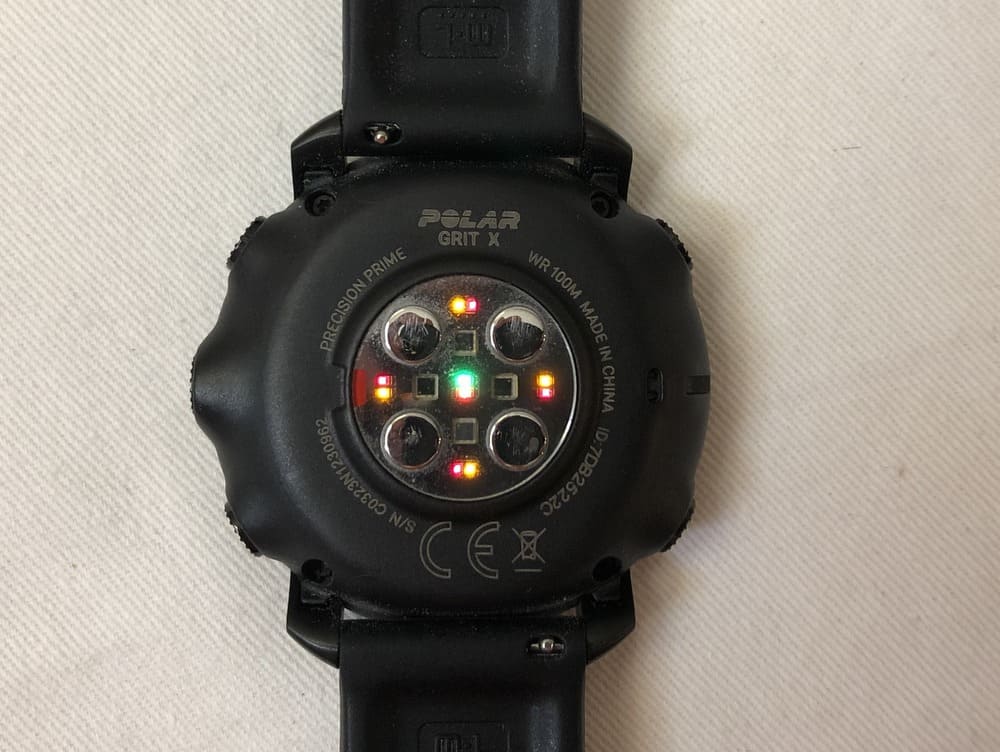
Unique #3:
I have never seen orange LEDs being used in sensors until I received the , but what I can say is that I have much more faith in Polar’s tracking than any other including the 6.
First off, the has the four metal circles that ensures contact with your skin. Then, the has 10 LEDs – four orange, five red and one green. It’s a pretty big departure from the green and red LED array on the .
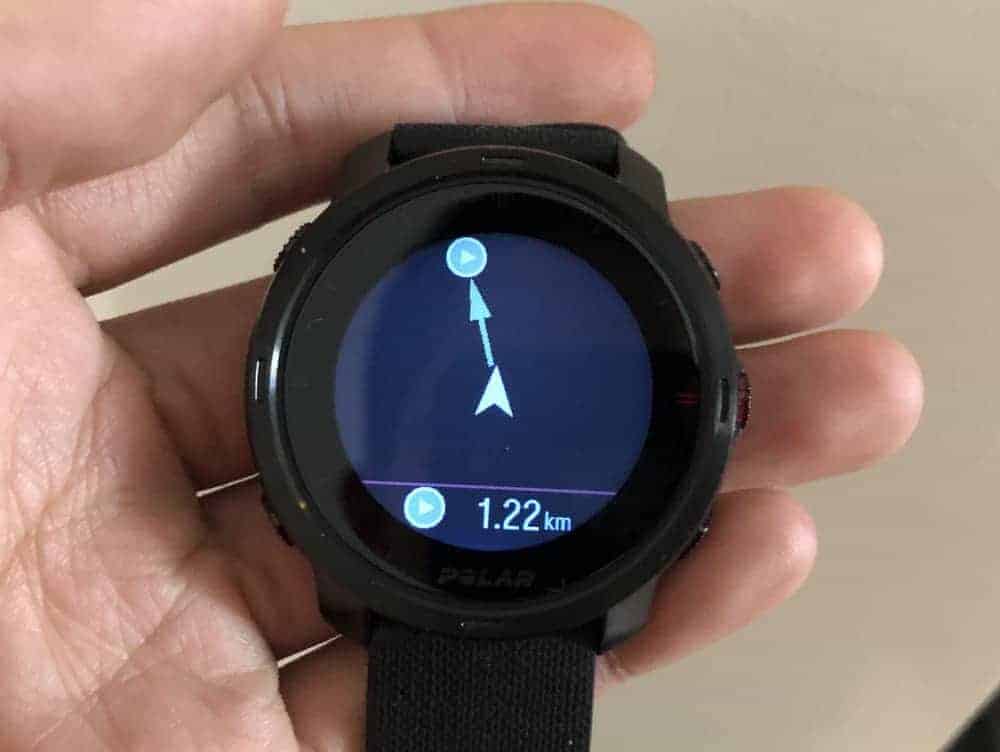
Ah, this is the closest thing to offline maps that the has. It’s great that there’s this but it requires some preparation.
Unlike an offline map which you can use without much preparation, such as on the 6, where you can create a route directly on the smartwatch, the Polar requires you to give it a GPS-based route beforehand or use one that was recorded in a previous session.
I’ve tried both. If you use Komoot, it’s much easier because you can just log into Komoot, create a route using their embedded map and when you save the route, it will get synced to your .
If you want to upload a GPX or TCX file, you can do it through the web app at flow.polar.com. But first you must find such a file and then upload it.
Sports tracking
The has over 130 different sports that you can track. I didn’t know it had so many sports to pick from until I went on their website to read about the ’s features.
I am pretty pleased that the allows you to pick up to 20 sports to load onto your including more obscure sports like futsal, disc golf and different styles of dancing.
Runners would love that there are profiles for ultra running, treadmill, track and field, jogging.
There are some advanced features for different sports, including an algorithm that measures and another that tracks swimming metrics.
, cadence and planning
This is one that’s really unique to Polar and would be a great way to gauge your power output on runs.
Polar uses its own proprietary algorithm that’s based on GPS, barometer and weight data to output data such as maximum power and lap power which is useful on hill climbs, interval or to maintain a steady pace when running.
Another interesting data point that the captures is the running cadence figure that the can give. It uses its accelerometer from your wrist movements to figure out your running cadence. This information helps you optimize your stride length, keep your cadence above a suggested 80/min (elite runners run between 85-95/min) and promises to improve running performance and avoid injuries.
You can pair this up with the Running Program on ’s web app. The Polar Running Program helps you plan your for your next race (5k, 10k, 21k or marathon). It will create a regime based on how often you train, how long your sessions are and the intensity of your physical activity.
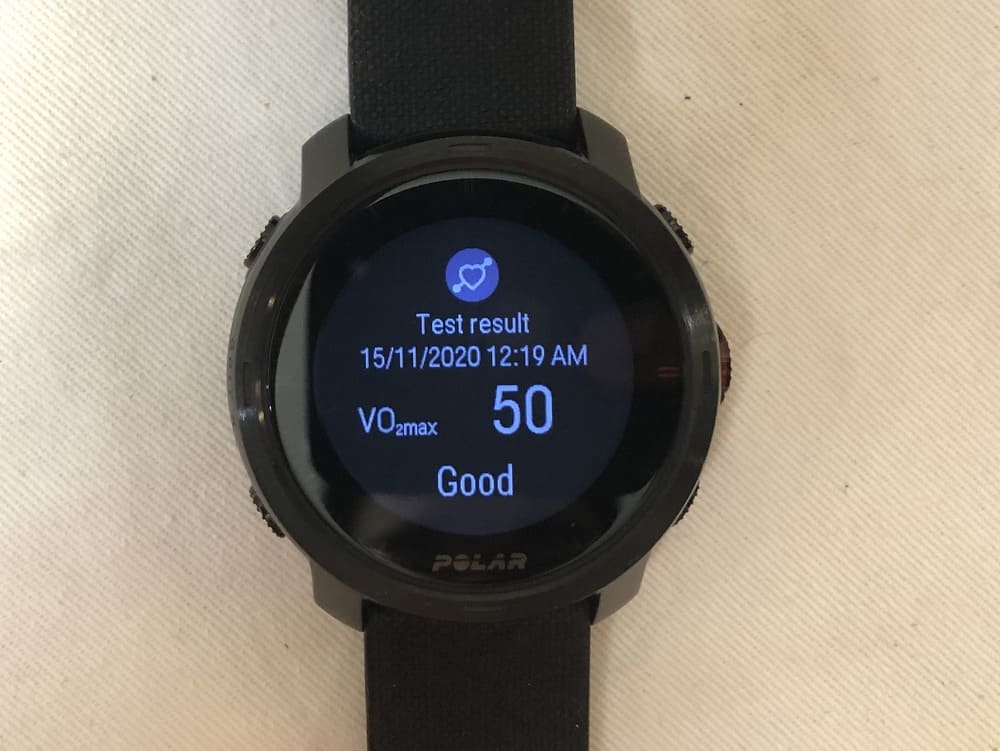
VO2Max measurement
One thing that I really like about the is that it can tell you VO2Max score by just asking you to lie down and wait.
I don’t know what the does but if you give it two minutes to do its thing, it will be able to give you a score. I got 50 which is “good.” That makes me happy and I think that’s why I like it.
Jokes aside, this fitness test considers your age and sex in order to classify you in one of the seven categories, with “elite” being the best and “very low” being the worst.
This is a great Polar innovation. Contrast this to the 6 which also has a VO2Max test, the Polar wins because the Fenix 6 requires you to go on runs before it can give you a figure. The only requires you to “lie down and relax” as the menu says.
Swimming metrics
While swim tracking isn’t a very revolutionary these days, Polar has some features that will interest pool swimmers.
The can measure your pace and distance, strokes, swimming style (freestyle, backstroke, breaststroke or butterfly).
Not all smartwatches will track underwater, but Polar says the is able to as long as you wear the even more snugly. This is great because you will be able to use this data to gauge your calorie burn and activity’s intensity.
Another measurement that’s unique is SWOLF which is best used as a gauge of your swimming efficiency. SWOLF adds together the time and strokes it takes you to swim a pool length. So, less time and fewer strokes gives you a lower SWOLF score, meaning your swims are more efficient.
faces that’s all about keeping active
In the ’s manual, there’s a section for faces. It’s pretty interesting that what they define as a face is what I would interpret as widgets or complications.
Here’s why. To me, a face is one which has a different design altogether. Using this definition, the has two faces — an analog and a digital face.
But if you swipe on the screen, you can change the information that you see from weather to FitSpark to Nightly Recharge. For the sake of consistency, let’s just call every new screen a “ face” as per Polar’s definition.
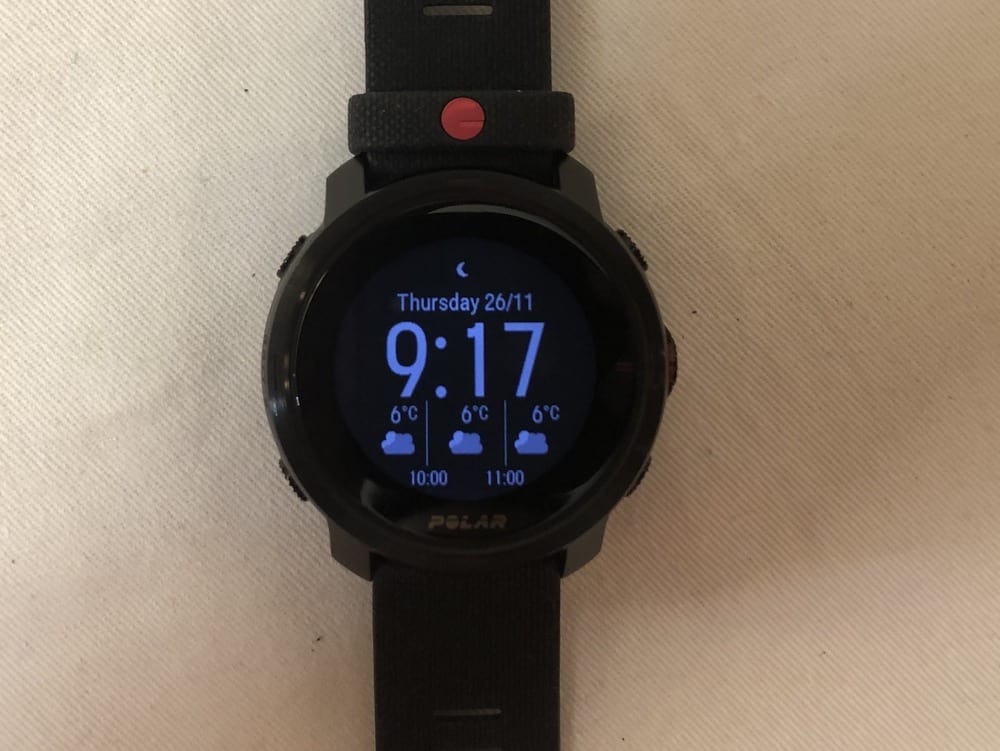
New weather face
The weather screen is new to the . I like this addition a lot because it helps the become just a bit “smarter.” Before, I would have to use my phone to check the weather whereas I can now do it right on the .
Then, there are the standard Polar faces that can be summed up as a 24-hour lifestyle, health and activity monitor.
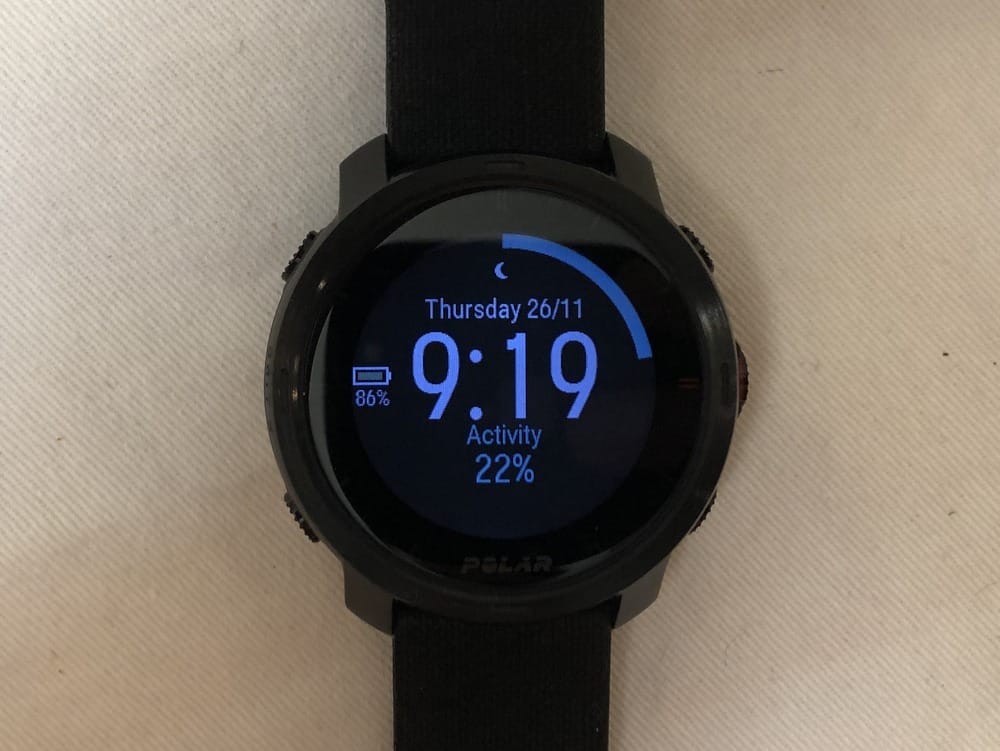
Activity, FitSpark, and Nightly Recharge
This is how Polar encourages you to keep a healthier lifestyle. Activity keeps you aware of whether you have been active enough in terms of steps and exercise, FitSpark suggests some workouts, monitors whether you’re improving, overworking or detraining, and Nightly Recharge monitors your condition based on your .
One thing that’s very obvious is the Activity ring which tells you whether you are hitting your goal. I like this a lot because it encourages me to find opportunities to keep active.
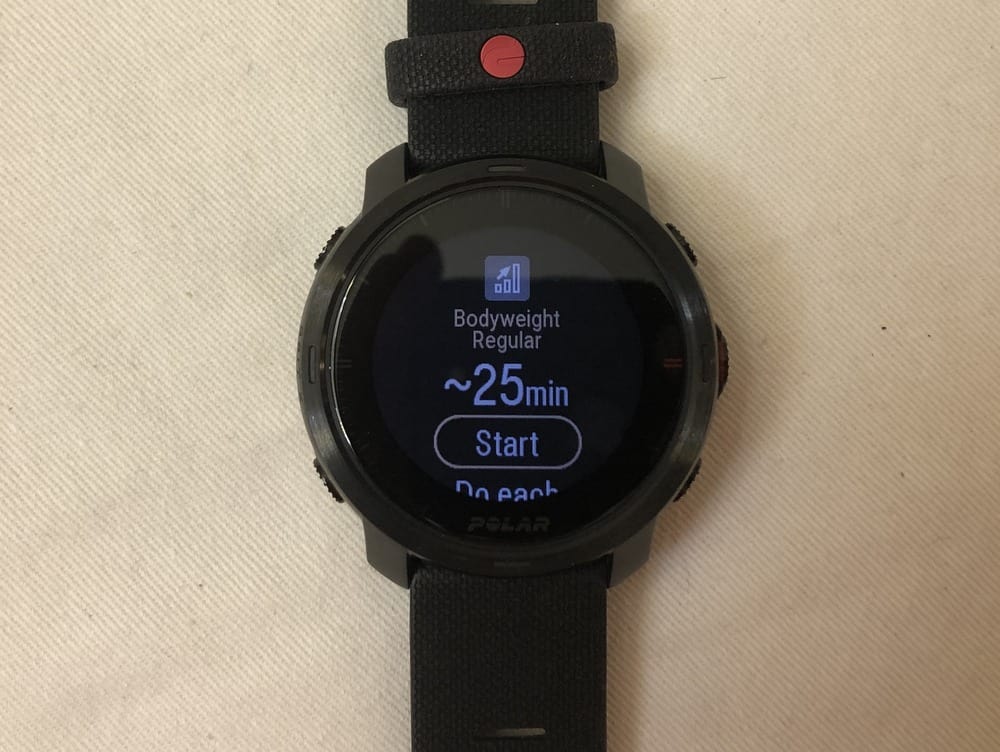
Then there’s the FitSpark which suggests daily routines in three areas — strength, cardio and supportive. FitSpark is pretty comprehensive in that it’ll suggest what it thinks is best based on your fitness level, history and your recovery and readiness. So, with the , you can expect .
Nightly Recharge measures your overnight recovery through considering how you slept and how well your autonomic nervous system calmed down during the early hours of . If it detects that you didn’t well, it will advise you on whether you should exercise, how to correct poor and how to regulate your energy levels through relaxation techniques. In essence, it’s a that goes beyond what most other trackers do. You can definitely
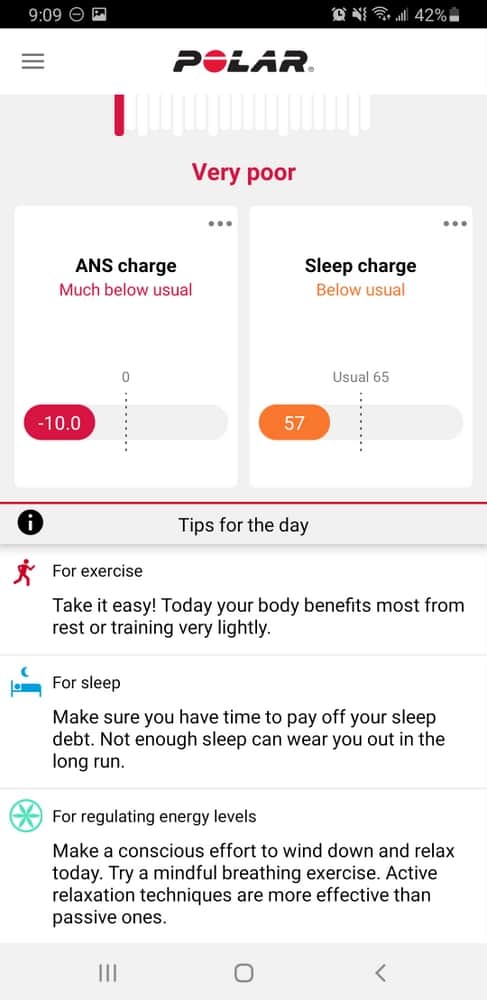
One day, I received a score of “Very Poor” and that’s when I got all this information. If it’s good, Polar will just tell you to go ahead with your day using different diction.
This comes down to which gives you an overall picture of how your fitness is changing. It uses data it has tracked over time and gives you a Cardio Load score based on how strenuous your workouts are. Then, you can also log your in the .
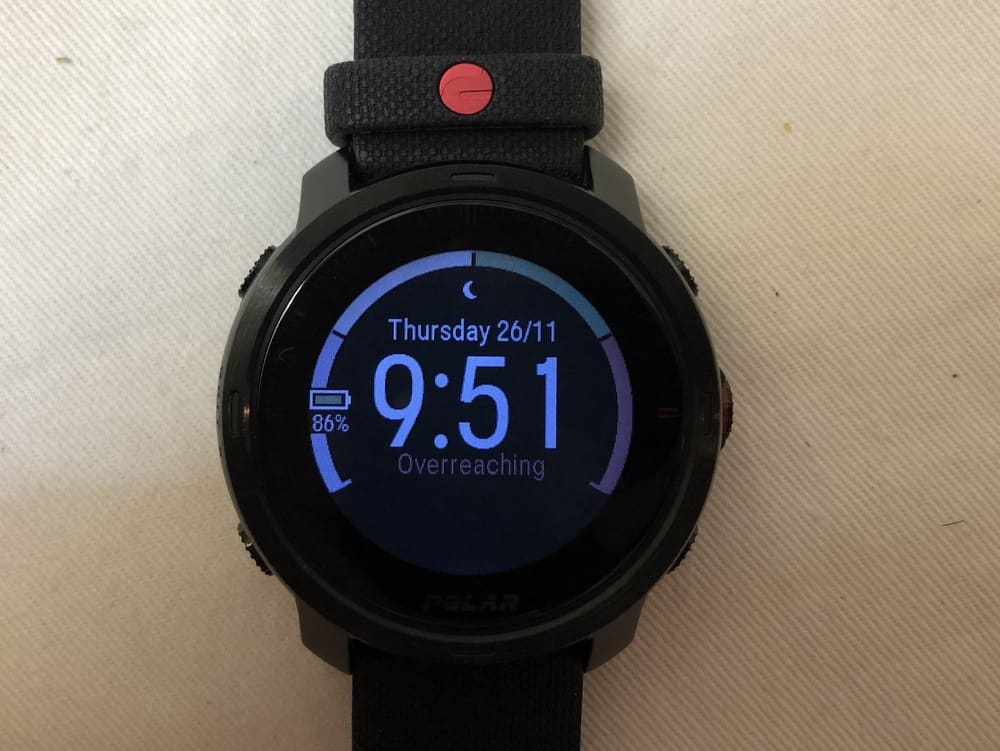
What I like about this is the comparison between short-term exertion that’s measured against long-term tolerance, respectively called Strain and Tolerance. Strain measures your average daily load from the past seven days. Tolerance uses data from 28 days. This is where it will start telling you whether you’re detraining, maintaining, productive or overreaching based on a comparison of Strain and Tolerance.
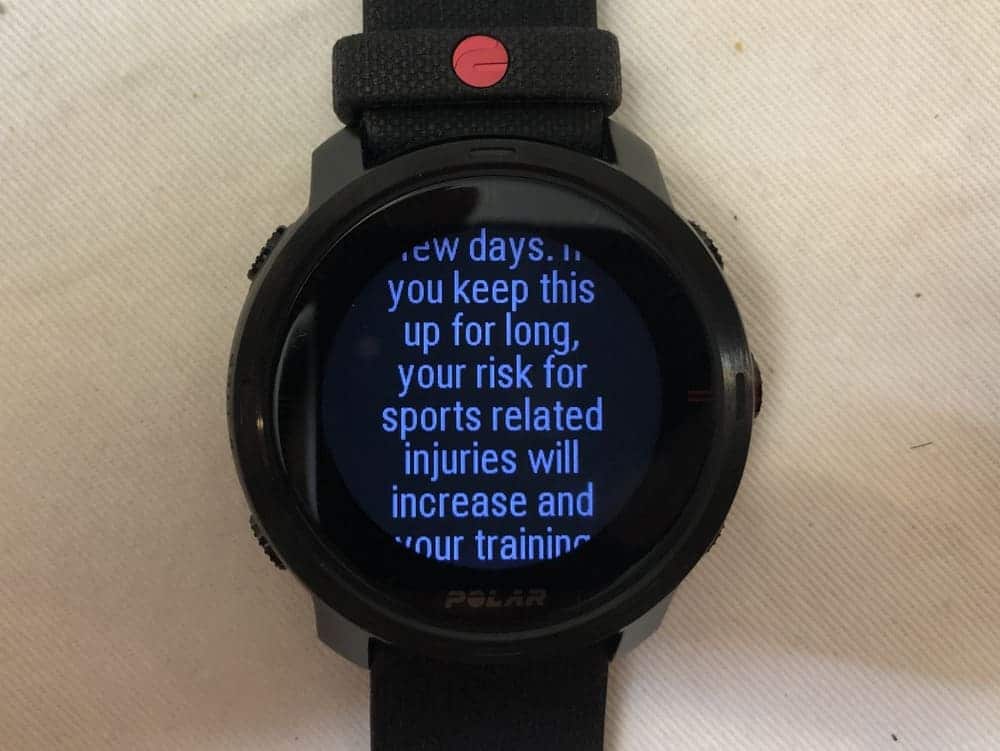
If you’re like me, you find it pretty motivating when you see the word “detraining” appear on your face. It’s just human nature to feel aggrieved when faced with loss, I suppose, and it really motivates me to think about exercising.
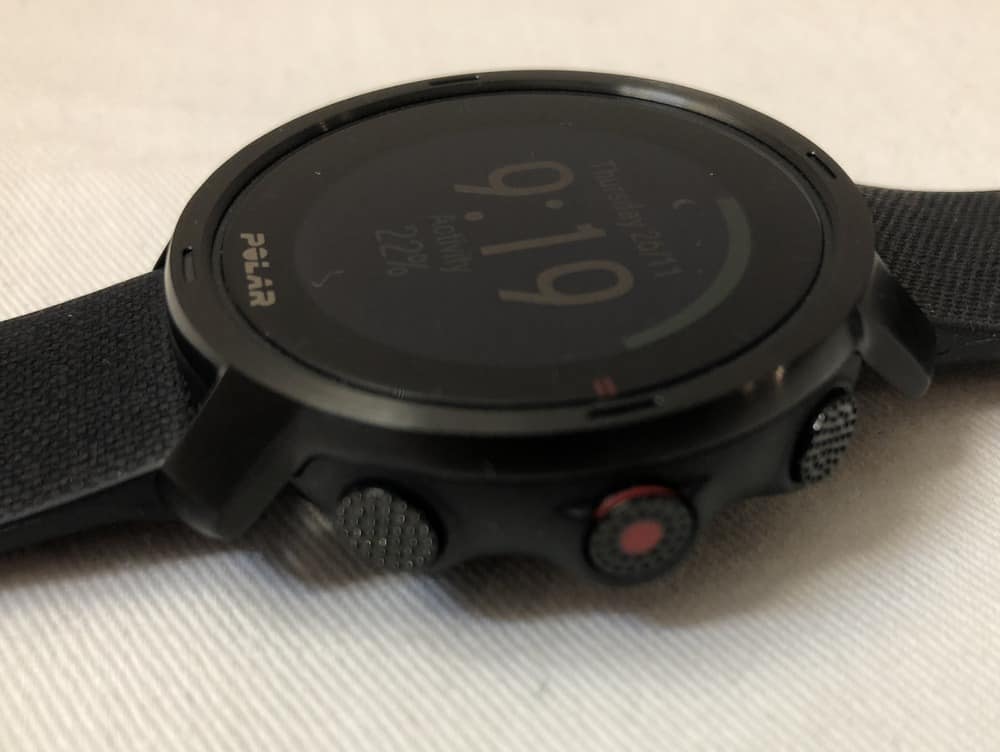
Verdict
The is a fantastic smartwatch that really can help you improve your fitness with the tools it offers.
However, the smartwatch really is laser focused on sports and nothing else. As a result, some of its productivity features really suffer. I have not seen another smartwatch from prominent brands that has such a poor way of managing notifications or one that has a touchscreen that’s so difficult to use.
Nonetheless, the ’s excellent , meter, exercise analysis and new features such as FuelWise really makes this the ultimate smartwatch for people looking to improve their sporting ability, especially if you are a runner.
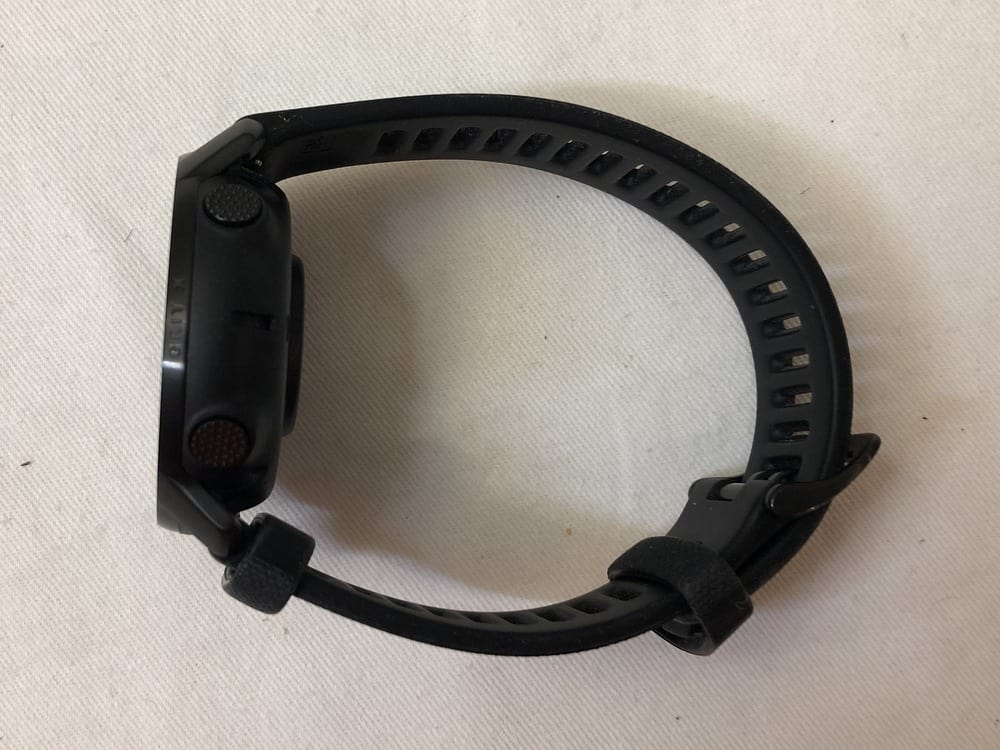
FAQs
Where to buy
You can buy the from Polar, Amazon, Best Buy and your local sports or tech retailer.
Specs
Dimensions: 47 x 47 x 13 mm
Weight: 64g with wristband
Display: 1.2” 240×240 pixels
Battery: 346 mAh, up to 40h in or 7 days in mode
GPS & Barometer: Integrated GPS, GLONASS, Galileo, QZSS. Assisted GPS for fast fix times. Barometric altitude, incline, ascent and descent
Connectivity: Bluetooth Low Energy. No ANT+. Custom USB cable for charging and data syncing.
Water resistance: 100m
Durability: MIL-STD-810G
How to use
The is primarily a smartwatch for and sports enthusiasts who need coaching features such as a running regime planner and also analysis of different data points to suggest exercises to undertake daily based on Nightly Recharge, Strain and Tolerance. FitSpark suggests what you should do daily in different areas: strength, cardio and supportive .
How to reset
You will need the cable that the came with and a computer. Then, use the following instructions from Polar:
- Go to FLOW.POLAR.COM/START and download and then install the Polar FlowSync data transfer software onto your computer.
- Connect your to the computer’s USB port.
- Open settings in FlowSync.
- Press the Factory Reset button.
- If you use Flow app to sync, check the list of paired Bluetooth devices on your phone, and remove your from the list if it’s there.
Polar Grit X vs Suunto 7
The Suunto 7 is one of my favourite sport smartwatches out there because it uses the Wear OS (operating system) from Google. This means it gets many productivity features such as easy texting, Google Assistant (voice assistant) and access to a big app store.
The Suunto 7 also offers offline maps which is really great. I really, really think this is the crowning feature of the Suunto 7.
That said, the Polar Grit X triumphs in all things related to sport. The Suunto 7 has a pretty advanced sports app, the Suunto app, but it’s nowhere near the comprehensiveness that the Polar Grit X can offer.
If you are seeking a smartwatch that is sport-first, then you need the Polar Grit X. If you want more productivity functions, the Suunto 7 is the best smartwatch that still qualifies as a sport-focused smartwatch.
Polar Grit X vs Polar Vantage V
They’re so similar it’s hard to really say which one I prefer. The Grit X is the newer of the two.
On the whole, most athletes could live with one or the other and get very similar results. Some differences include the Polar Grit X having the Hill Splitter, FuelWise, route navigation, weather and an energy source breakdown of workouts.
The Polar Grit X has a newer heart rate sensor with yellow, red and green LEDs while the Vantage V only has green and red LEDs. In practice, I did not notice any difference.
The Vantage V has the Recovery Pro feature which tells you whether you are ready for a cardio workout or not and it also has the Orthostatic Test which requires a chest heart rate sensor and tells you whether you have recovered from your workout.
Polar Grit X vs Garmin Fenix 6
You’ll never pry my hands from the Garmin Fenix 6. It’s the watch that I wore when I was away from home for months, roughing it out.
I’d take the Polar Grit X, sure, but I would lose out on a few features.
I like the Garmin Fenix 6’s offline maps. I like the way it looks. I like the watch faces that allow you to customize the information on it. I like its music feature. I like that it can reply to messages (albeit only with pre-composed messages) and I like the friendliness of the Garmin Connect app.
The Garmin Fenix 6 would last a week before it got down to 30% while the Polar Grit X could last four days.
Now, the Garmin Fenix 6 is neck and neck in terms of the features it has but it’s not as laser focused as the Polar Grit X.
The Polar Grit X offered me more motivation to exercise because every watch face focused on health and sports. From the activity meter to FitSpark, the Grit X is much more direct in its encouragement to get you out exercising.
Polar Grit X vs Fitbit Sense
As I was gathering information online, preparing to write about the Fitbit Sense, I noticed that I have been fiddling with the Fitbit Sense for no reason.
I realized the reason why I liked it so much was because its Infinity Band was so sleek and smooth. The texture of the rubber-silicone styled band just felt so good to play with. Coupled with the very modern, svelte look of the Fitbit Sense’s watch case.
The watch case is square with rounded edges and a curved-edge glass. It’s mostly flat on both sides which makes it so much more comfortable to wear.
Both watches are 24/7 watches because they need all the data they can get in order to give you a proper health snapshot. Wearing the Polar Grit X to bed felt a lot more noticeable than the Fitbit Sense.
That said, again, just like all other watches, the Fitbit Sense can’t compare to the Polar Grit X in terms of its sports-focused features. The choices of workouts are fewer with the Fitbit Sense and the data is much thinner. The rift is even further if you don’t pay for Fitbit Premium as Fitbit keeps certain data under a paywall.
But remember, when you buy the Fitbit Sense, you are saying that you want a smartwatch that’s much more convenient for daily use. You can reply to messages, play music and use a voice assistant. And it’s a lot cheaper too.
Polar Grit X vs Fitbit Versa 3
The Versa 3 isn’t much different than the Fitbit Sense. The only major difference, externally, is that the Sense’s perimeter is conductive (for an EDA scan) while the Versa 3 isn’t.
The arguments as to whether you should get a Polar Grit X or a Fitbit Versa 3 really come down to the same arguments for the Sense vs the Grit. Then, you will have to further consider whether you need the extra capabilities of the Fitbit Sense.
Polar Grit X vs Apple Watch Series 6
You just can’t beat the ultimate smartwatch.
I really like the Apple Watch Series 6. Its design, software and overall functionality is just unbeatable.
While there’s some overlap in terms of health and workout functions, the Polar Grit X is still far ahead in terms of its analysis of sports, health and workouts.
But the Apple Watch is far ahead in terms of its abilities to make life less tedious and more convenient. You can send replies to messages, read your email logs, accept calls, download third-party apps and more.
Just remember that the Apple Watches only pair with iPhones. So you are out of luck if you use an Android.
Polar Grit X vs Fossil Gen 5 Carlyle
The Fossil Gen 5 series of smartwatches is probably my favourite Wear OS smartwatch line.
The reasons for that include great performance, great productivity features and a good range of designs to pick from. The Fossil Gen 5 is a full-featured Wear OS smartwatch.
If I had an iPhone, I would get the Apple Watch. But since I don’t, I would probably pick the Fossil Gen 5 Carlyle (if not the Suunto 7).
But when would I pick the Polar Grit X instead of the Fossil Gen 5?
That time will come if I am committed to a sport, a race or somehow I needed something to improve my activity levels and lifestyle.
Polar Grit X vs Fossil Sport Smartwatch
Here we enter into the entry-level Wear OS smartwatches.
They still offer a lot of features such as a reliable messaging system and a great voice assistant.
It’s also a lot lighter than most smartwatches including the Polar Grit X. The Fossil Sport Smartwatch is probably one of the least intrusive watches out there. Sometimes, I forget that I even have that smartwatch on my wrist.
The Fossil Sport really suffers in its battery life, though, and that really just makes it very inconvenient. I really like having an always-on screen and this really tests the Sport’s battery life. Often, I find myself struggling to make it through the day with the Sport.
The battery life is the most severe issue with the Fossil Sport. Especially if you contrast it with the multiple day battery life of the Polar Grit X.
Polar Grit X vs Ticwatch Pro
Mobvoi’s Ticwatch Pro has a weight to it that really makes it feel like a “solid” watch.
Few smartwatches are made from a metal watch case but I am really glad the Ticwatch Pro decided to choose its own way.
Compared to the Polar Grit X, it looks much more of a formal watch with its leather strap and shiny surfaces.
The Ticwatch Pro can also take and make calls because it has a speaker. This is a really big convenience that I really appreciate.
However, the Polar Grit X triumphs over the Ticwatch Pro because the latter isn’t suitable to be taken underwater. The Polar Grit X also has much better analysis of workouts and has sleep tracking, running power and other features not available to the Ticwatch Pro.
The Ticwatch Pro also has really dated hardware so it can be laggy sometimes.
Polar Grit X vs Ticwatch C2/E2/S2
Mobvoi’s entry level smartwatches, the C2, E2 and S2 are great smartwatches for people looking for something reliable and useful.
The productivity features that come with the Ticwatch C2, E2 and S2 are very similar. Unlike the Ticwatch Pro, they don’t have a speaker so you can’t take or make calls. Otherwise, they’re very similar.
The rift between the Grit X and the Ticwatch C2, E2 and S2 is large. First and foremost, there’s a major price difference, and the corollary is that there should be a major difference in features.
Yes, the Polar Grit X is a great smartwatch for folks who need a specialized smartwatch meant to enhance an athlete’s performance while the Ticwatch C2, E2 and S2 are more suitable for most people’s needs.
Polar Grit X vs Samsung Galaxy Watch3/Active2
The Samsung Galaxy Watch3 and Samsung Galaxy Watch Active 2 are two fantastic smartwatches that rank at the top in terms of design.
The Galaxy Watch3 also has the amazing rotating bezels that are an amazing innovation of Samsung’s.
Again, it’s a general purpose smartwatch so the Samsungs can’t compete with the Polar Grit X if you’re looking for something with very advanced sports features.
However, unlike the average Wear OS smartwatch, the Samsung line of smartwatches integrates very well with Samsung phones and also allows you access to Samsung Health, which I really like.
Samsung Health is no Polar Flow, but it’s very good because it can keep track of most things the Polar Flow keeps track off, in addition to having a pretty comprehensive nutrition tracker.



